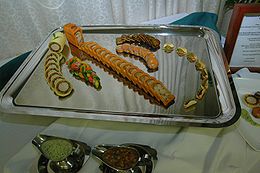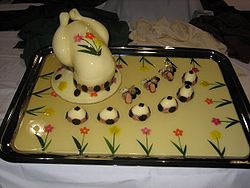
Garde manger
Encyclopedia

Salad
Salad is any of a wide variety of dishes, including vegetable salads; salads of pasta, legumes, eggs, or grains; mixed salads incorporating meat, poultry, or seafood; and fruit salads. They may include a mixture of cold and hot, often including raw vegetables or fruits.Green salads include leaf...
s, hors d'œuvres, appetizers, canapes, pates and terrines) are prepared and other foods are stored under refrigeration. The person in charge of this area is known as the chef garde manger. Larger hotels and restaurants may have garde manger staff perform additional duties, such as creating decorative elements of buffet presentation like ice carving and edible centerpieces made from materials such as cheese, butter, salt dough
Salt dough
Salt dough is a modeling material made from a mixture of flour, salt and water. Food coloring is often used to color the material.Due to its high salt content, it is not suitable for ingestion, although the salt also gives it an offensive taste making such attempts unlikely even among inquisitive...
or tallow
Tallow
Tallow is a rendered form of beef or mutton fat, processed from suet. It is solid at room temperature. Unlike suet, tallow can be stored for extended periods without the need for refrigeration to prevent decomposition, provided it is kept in an airtight container to prevent oxidation.In industry,...
.


History
The term "garde manger" originated in pre-RevolutionFrench Revolution
The French Revolution , sometimes distinguished as the 'Great French Revolution' , was a period of radical social and political upheaval in France and Europe. The absolute monarchy that had ruled France for centuries collapsed in three years...
ary France. At that time, maintaining a large supply of food and beverage was an outward symbol of power, wealth and status. It is because of this duty of supervising the preserving of food and managing its utilization that many interpret the term "garde manger" .
The food storage areas in these castle
Castle
A castle is a type of fortified structure built in Europe and the Middle East during the Middle Ages by European nobility. Scholars debate the scope of the word castle, but usually consider it to be the private fortified residence of a lord or noble...
s and manor house
Manor house
A manor house is a country house that historically formed the administrative centre of a manor, the lowest unit of territorial organisation in the feudal system in Europe. The term is applied to country houses that belonged to the gentry and other grand stately homes...
s were usually located in the lower levels, since the cool basement-like environment was ideal for storing food. These cold storage areas developed over time into the modern cold kitchen.
Most merchants who worked outside noble manors at this time were associated with a guild
Guild
A guild is an association of craftsmen in a particular trade. The earliest types of guild were formed as confraternities of workers. They were organized in a manner something between a trade union, a cartel, and a secret society...
, an association of persons of the same trade formed for their mutual aid and protection. Guilds would develop training programs for their members, thereby preserving their knowledge and skills. "Charcuterie
Charcuterie
Charcuterie is the branch of cooking devoted to prepared meat products such as bacon, ham, sausage, terrines, galantines, pâtés, and confit, primarily from pork. Charcuterie is part of the garde manger chef's repertoire...
" was the name of a guild that prepared and sold cooked items made from pigs. Through this organization, the preparation of hams, bacon, sausages, pates and terrines were preserved. When the guild system was abolished early in the French Revolution in 1791, garde mangers took on the responsibility for tasks that had formerly been performed by characutieres, who had difficulty competing with the versatile garde mangers due to the limited range of skills involved.
The position of "butcher
Butcher
A butcher is a person who may slaughter animals, dress their flesh, sell their meat or any combination of these three tasks. They may prepare standard cuts of meat, poultry, fish and shellfish for sale in retail or wholesale food establishments...
" first developed as a specialty within the garde manger kitchen. As both the cost of and demand for animal protein
Protein
Proteins are biochemical compounds consisting of one or more polypeptides typically folded into a globular or fibrous form, facilitating a biological function. A polypeptide is a single linear polymer chain of amino acids bonded together by peptide bonds between the carboxyl and amino groups of...
s (in the form of pork
Pork
Pork is the culinary name for meat from the domestic pig , which is eaten in many countries. It is one of the most commonly consumed meats worldwide, with evidence of pig husbandry dating back to 5000 BC....
, beef
Beef
Beef is the culinary name for meat from bovines, especially domestic cattle. Beef can be harvested from cows, bulls, heifers or steers. It is one of the principal meats used in the cuisine of the Middle East , Australia, Argentina, Brazil, Europe and the United States, and is also important in...
, etc.) increased, more space was required for the task of fabricating and portioning the raw proteins. This increased need for space was due not only to an upswing in the volume of protein sales, but also to the need for separating raw proteins from processed foods to avoid cross-contamination and the resulting possibility of foodborne illness
Foodborne illness
Foodborne illness is any illness resulting from the consumption of contaminated food, pathogenic bacteria, viruses, or parasites that contaminate food, as well as chemical or natural toxins such as poisonous mushrooms.-Causes:Foodborne illness usually arises from improper handling, preparation, or...
.

